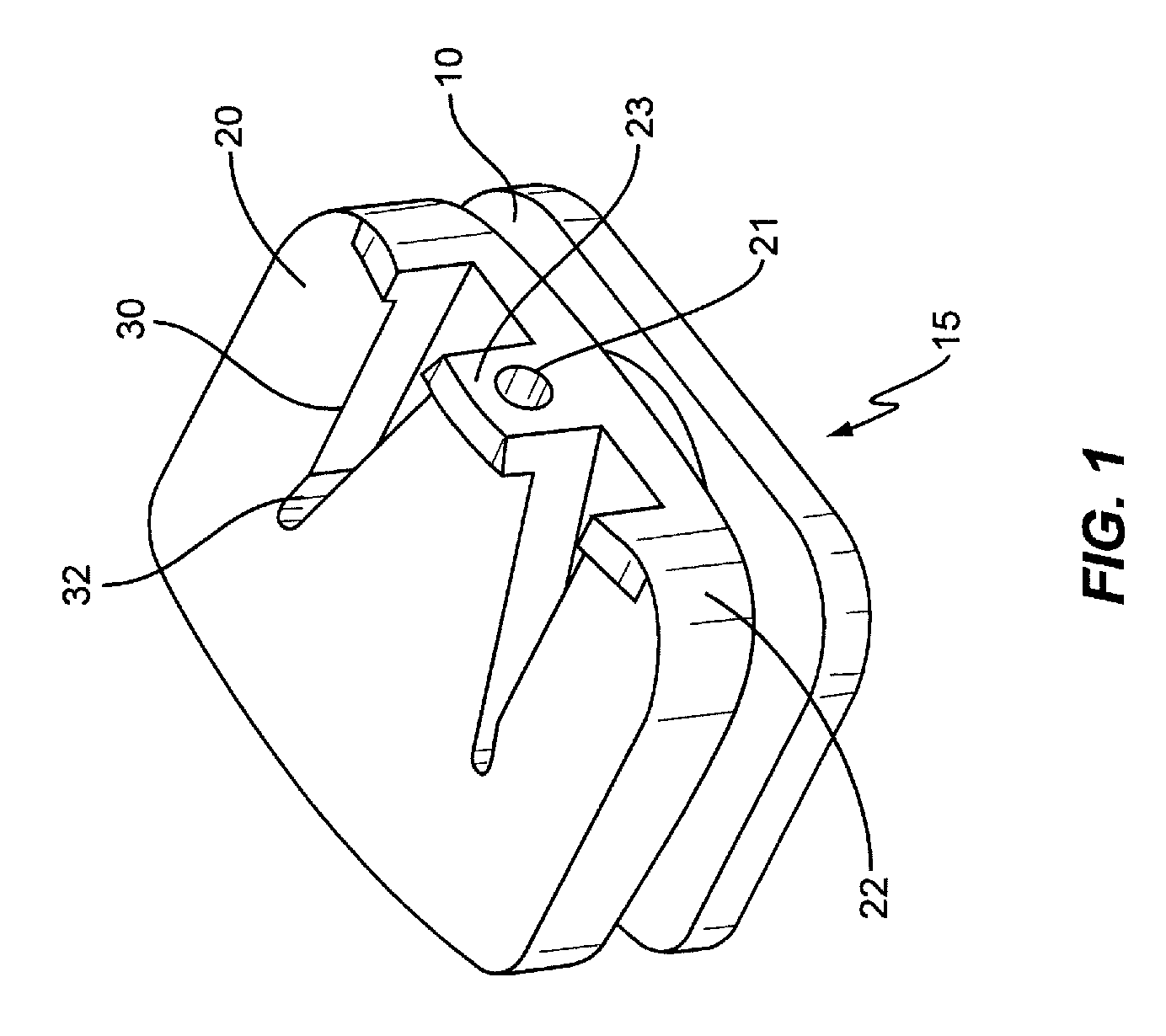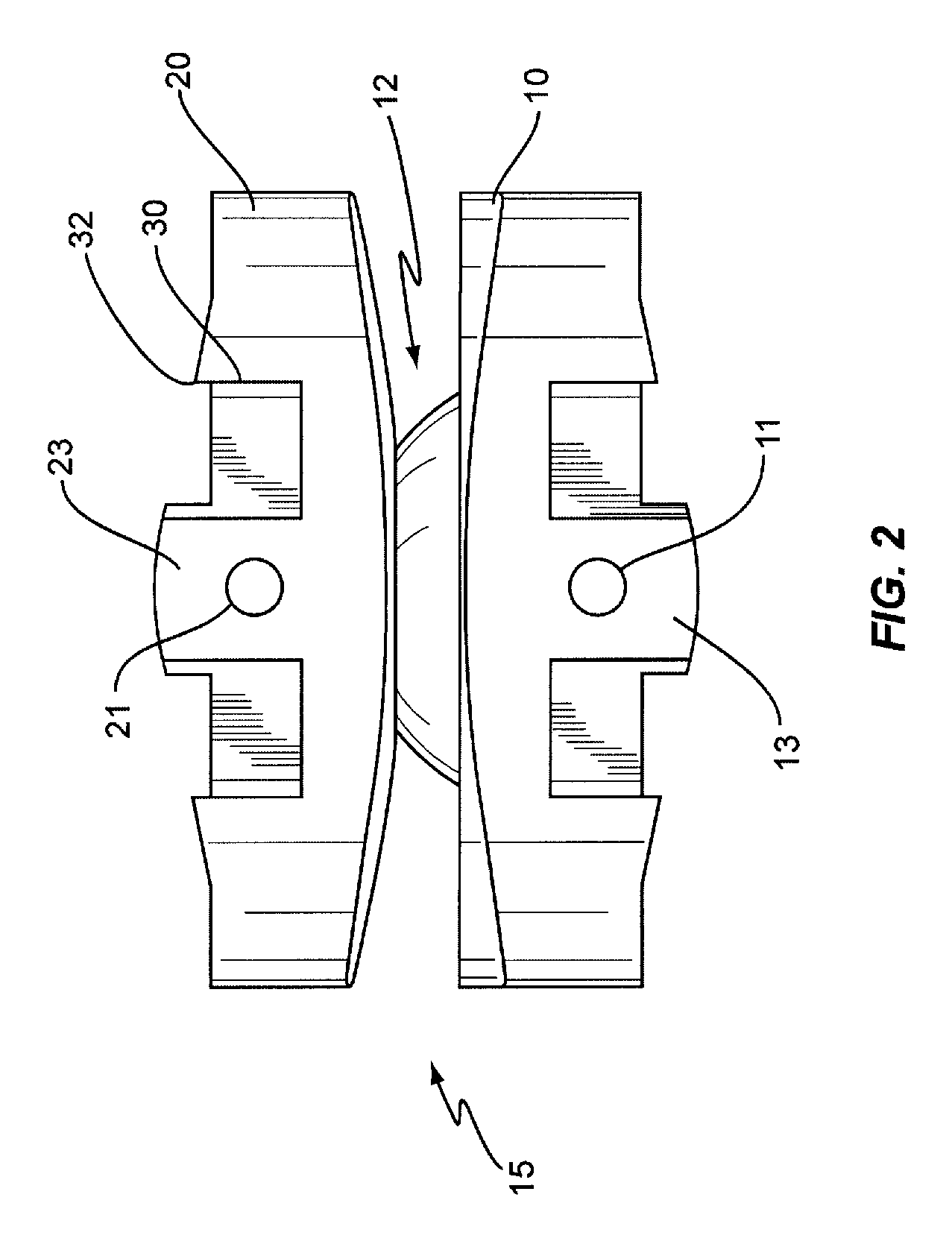V-shaped staple for spinal prosthesis
a technology of spinal prosthesis and staple, which is applied in the direction of surgical staples, prosthesis, osteosynthesis devices, etc., can solve the problems of degenerated disc shrinkage, rupture, and prone to injury and degeneration of intervertebral discs, so as to prevent backing out of intervertebral implants and maintain stability. the effect of the intervertebral implan
- Summary
- Abstract
- Description
- Claims
- Application Information
AI Technical Summary
Benefits of technology
Problems solved by technology
Method used
Image
Examples
first embodiment
FIG. 3 shows a V-shaped staple 40, which is part of the present invention. The V-shaped staple 40 comprises two arms 44, and each arm 44 has an end 48 which is pointed (or sharp) for penetrating the endplate of each vertebrae to which the plates 10 or 20 are being affixed. The overall shape of the staple 44 before use can be described as generally rectangular. V-shaped staples of the present invention may be made from materials including titanium, titanium alloys such as nickel-titanium, stainless steel and cobalt chromium, PEEK, PEEK-carbon composites and / or any combination of the above.
second embodiment
In isometric views, FIGS. 4A and 4B demonstrate the procedure, and specifically the beginning and end stages, for implanting the V-shaped staple 40 into the superior plate 20 of the spinal implant 15 of the present invention. In FIG. 4A, the V-shaped staple 40 is introduced to the implant 15 and the vertebra (not shown). The V-shaped staple 40 can simply be hammered or power-driven through the vertebra that lies above the superior plate 20, while the V-shaped staple 40 moves through the grooves 30 and 32. That is, because of the material of the V-shaped staple 40 and the shape of the groove 30, the V-shaped staple 40 will yield to the groove 30 and change shape from a generally rectangular shape of FIG. 3 to the V-shaped staple of FIGS. 4B. That is, the angle α of each arm 44 of the V-shaped staple 40 from centerline CL (which also can be described as an angle outward from the centerline it moves from the anterior portion to posterior) is in the range of ½ degree to 15 degrees. Such...
third embodiment
A third embodiment of the present invention is illustrated and described with reference to FIGS. 3, 5, 9A, 9B, and 10. FIG. 3 shows a V-shaped staple 240, while FIG. 5 depicts an artificial disc 115 that also can be used with V-shaped staple 240. Like the first two embodiments, the V-shaped staple 240 is made of the same materials, but typically is of a smaller thickness. Specifically, for the first and third embodiments of the V-shaped staple, the preferred range of thickness is in the range of 0.3 mm. to 1.0 mm. for metal materials, and 0.5 mm. to 3.0 mm. for non-metal materials. For the second embodiment, although it can be thinner than the other embodiments, the preferred range of thickness is in the range of 0.3 mm. to 3.0 mm. for all materials. Similarly, for the first and third embodiments of the V-shaped staple, the preferred range for angle α from the centerline CL is ½ degree to 15 degrees. For the second embodiment, however, the preferred range for angle α from the center...
PUM
 Login to View More
Login to View More Abstract
Description
Claims
Application Information
 Login to View More
Login to View More - R&D
- Intellectual Property
- Life Sciences
- Materials
- Tech Scout
- Unparalleled Data Quality
- Higher Quality Content
- 60% Fewer Hallucinations
Browse by: Latest US Patents, China's latest patents, Technical Efficacy Thesaurus, Application Domain, Technology Topic, Popular Technical Reports.
© 2025 PatSnap. All rights reserved.Legal|Privacy policy|Modern Slavery Act Transparency Statement|Sitemap|About US| Contact US: help@patsnap.com



